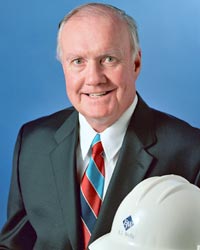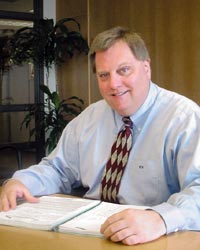|
Value-added services key to serving construction business Specialists grow by maintainingn dialogue with contractors and total management of risk By Sandra Carcione
Contractors have enjoyed explosive growth in many of the major geographic markets throughout the United States, in both commercial and residential arenas. At the same time, some insurance issues are changing the way that contractors—and the agencies that serve them—are doing business. Construction product parameters are tightening, some coverages have been eliminated or redrawn and it looks as though pricing is beginning to soften, at least in some markets. In addition, in many markets insurers are emphasizing financial under-writing, which dictates the level of program based on contractor asset health. In many cases, this revised focus calls for higher retentions and better contractor financial/loss management than ever before. As a result of all these changes and others, agencies that offer value-added risk management services, education for the contractor, assistance with employee practices, and other specialized services are prospering in this market. Paul Coffey, president of EJ Wells Insurance Agency in Westford, Massachusetts, says that renewal premiums are averaging 15% to 20% less than last year because insurers are finally backing off the high reserves mandated by 9/11 and capacity is flowing back into the marketplace. Luckily, Coffey says, his agency doesn’t sell on price, but offers value-added services to hand-picked commercial contractors and subcontractors in the Boston, New Hampshire and Rhode Island marketplace. The importance of value-added The EJ Wells agency has about $12 million in premium, seven full-time employees and two part-timers. The agency serves only contractors, confined to privately owned relatively large companies (the largest has $100 million in revenue) that include several general contractors as well as specialty subcontractors. “We are specialists and that gives us validity in the marketplace among insurers and among contractors. We provide a written service agreement to each of our clients and a service package that includes such things as an annual review of workers compensation experience rating, loss control and risk transfer strategies,” says Coffey.
Frank H. Furman Insurance, Inc. in Pompano Beach, Florida, provides human resources consulting as one of many value-added services for its contractor clients. An agency staffer assists clients with wage and hour issues and helps develop company-specific procedures, an employee benefit handbook and anti-sexual harassment policies. “We have found that less than 15% of typical construction professionals have dedicated HR departments,” says Rob Foote, executive vice president. “We establish a separate fee agreement with the contractor based on the scope of work and the specific human resource services provided. This allows the contractor to reach out to us as their advisor instead of turning to a labor law attorney.” Foote says the agency has a relationship with two local employment law firms, which handle legal matters through the Furman Agency on behalf of its clients. This $80 million premium agency has two offices (in south and central Florida) and 55 employees. More than 70% of the agency’s book is construction accounts and much of that is in high-hazard professions such as roofing contractors. Risk management is king The construction specialists we spoke to get intimately involved in their clients’ contract process, particularly related to risk avoidance and loss management. This is extremely important because of changing and more restrictive provisions under general liability and umbrella policies. For example, ISO forms that were revised in mid-2004 are greatly restricting the scope of additional insured endorsements, such as those for bodily injury and property damage once work on a project is completed. In addition, many carriers are reducing coverage scope, such as excluding defense inside the limits of liability. One way contractors are reacting is to increase deductibles. “To avoid costs from going sky high, contractors are substantially increasing their deductibles,” says Foote. “A mid-size trade contractor may have a $100,000 deductible for general liability. Overall, we think this is a good thing, since it causes contractor management to exercise higher standards of care than ever before.” He says the Furman agency, which specializes in higher hazard construction risks, provides a contract review to help clients avoid liabilities that fall outside their coverage scope. The agency also provides its general contractor clients with a subcontractor requirement checklist to identify when any subcontractor is out of compliance. “We want to make certain that liability flows downstream to second- and third-tier subcontractors,” says Foote. A special database tracks all of a client’s subcontractors and flags any that have a cancellation of workers compensation pending for nonpayment of premium or other reasons. If there is a severe injury or death, the agency dispatches its in-house safety professionals to perform a comprehensive interview with the foreman, crew chiefs and any witnesses from the jobsite. The agency also attends informal and formal conferences with OSHA as a contractor’s advisor and consultant. “We feel that our participation at this high level further illustrates our partnership with our construction clients,” says Foote. The agency has also begun providing clients with an Internet-based OSHA safety compliance program, which is tailored specifically for their specialized exposures.
Schiff, Kreidler-Shell (SKS), Inc., in Cincinnati, Ohio, uses a comprehensive risk management approach. “We help our clients identify risks, select appropriate risk treatment solutions and set up administration for all levels of business risk,” says Robert Higgins, vice president. The agency also provides its clients with risk assessment models aimed at quantifying the risk exposures that have been identified through the risk management process. This $100 million premium agency, which was established in 1876, has 110 employees in two offices (Cincinnati and Ft. Mitchell, Kentucky), and focuses on commercial lines. SKS has a long history of providing insurance and related services to the construction industry and is one of the largest surety providers in the region. “We have a dedicated surety person, which is somewhat unique for most insurance agencies. Surety must have a specialist,” says Higgins. “The agency also provides counsel and services in the alternative risk funding area; however, only the very large contractor clients are able to utilize ART as a funding mechanism these days.” SKS also works with its largest construction clients in the feasibility, design, placement and administration of construction wrap-ups, which are consolidated insurance programs in which the general contractor or the project owner provides the casualty insurance for all the contractors involved in a large project. Higgins notes, “This avoids finger pointing when a claim occurs and adds cost advantages over traditional insurance delivery mechanisms due to economies of scale.” As part of its overall risk management services, SKS helps clients with loss analysis and trending. “One of the best techniques for prevention of losses is to analyze historical losses—both within your own organization and within your industry. We help our clients with this process,” says Higgins. The agency also provides clients with a stewardship report before each renewal. “We go over what has happened during the year and what they can expect in the coming renewal,” says Higgins. Proactive claims handling Even with the best risk management and loss control strategies, there are bound to be claims in construction. Agents specializing in this market agree that frequent communication with clients is critical during the claims process. “We get a copy the same day an incident happens and get regular updates on the status,” says Coffey of EJ Wells. SKS has a four-person claims department that helps clients with the filing and final settlement of their claims with their insurance company. The agency also works with clients on evaluating and understanding their losses. The Furman agency has an in-house claims department that works with contractors, legal representatives and the insurer from start to finish. “Claims can create an adversarial relationship, so we make sure we’re the client’s advocate,” says Foote. The agency provides quarterly claims reviews to get client and carrier feedback on how to reduce claims cost. Providing contractor education Clearly, preventing losses is preferable to having a loss occur, so SKS and the other agencies are focused on loss prevention by providing a variety of safety education programs, including OSHA certification and compliance. Fleet safety is another area of focus for SKS. “We help clients develop policies and procedures for fleet safety, including driver selection and acceptability. Our large contractors may have upwards of 200 vehicles, and this area of risk requires just as much attention to loss prevention and control as the worksite,” says Higgins. The Furman agency recently conducted a Torch Applicator Training Program for many of its key construction clients, which was aimed at training crew chiefs, foremen and lead workers on proper installation techniques of particular construction processes. The agency also holds “Mold Awareness” training programs to educate contractor personnel. EJ Wells provides crane safety programs and employee practices seminars for its contractor clients. Agency/contractor marketing The three agents we spoke with do not actively prospect for new construction business. Instead, they derive most of their business from referrals within the construction industry. All are active in construction trade associations, including the Construction Financial Management Association. Coffey says his agency is very selective about what business it takes on. “We reject nearly 90% of prospects out of the gate because of management practices or other problems,” he says. “We spend 40 to 50 hours reviewing everything about the account as well as five years of loss runs and at least two years of financials.” The Wells agency can afford to be picky, Coffey says, because they don’t have a sales force. “Typically, 25% to 30% of an agency’s revenue is devoted to sales. Instead we take a percentage of our commission dollars and put them into value-added services. If a contractor client has problems we can’t solve, we hire a specialist to provide solutions and the agency pays the fee.” In 1999, Coffey trimmed back the agency’s volume of accounts by half—from 50 to 25. He is a strong believer in the 80/20 philosophy (80% of revenue coming from 20% percent of accounts) and the need to concentrate on select clients, promoted by insurance consultant Roger Sitkins. The account reduction has turned out to be a good move for the Wells agency. Accounts average $500,000 in annual premium. Sometimes, agencies help contractors with their marketing efforts. SKS helps clients expand into new market areas, by using its contacts in various trade associations and through industry resources, such as Assurex Global, a consortium of insurance agencies with both U.S. and international connections. The Furman agency provides contractor clients with a letter of recommendation that they can use to acquire business. The letter highlights the loss control and safety-related disciplines that a particular contractor displays. “In addition, we include information on the financial stability of the firm as well as bonding capacity of the organization,” Foote says. “We encourage our clients’ sales and project management team to lift up some attributes of their protection, and highlight the benefits of having a construction professional with adequate excess general liability and umbrella protection.” These construction specialists all believe that providing value-added service to a select number of good accounts or specializing in a particular contractor category such as roofers or elevator installers is a more profitable stance than taking on any business that walks through the door and treating it as a commodity. As policy provisions tighten, prompting higher risk retention among contractors, these business owners are looking for their agencies’ help as never before in risk management, loss control and safety education. And, they reward their agencies with referrals and long-term loyalty. * |
||||||
|





